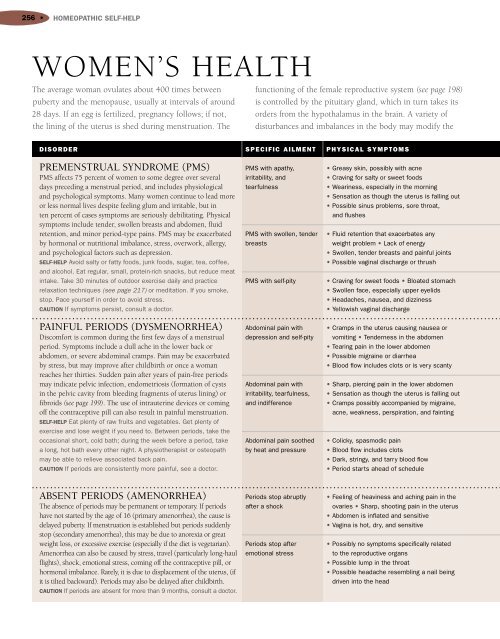Encyclopedia of Homeopathy
Encyclopedia of Homeopathy
Encyclopedia of Homeopathy
Create successful ePaper yourself
Turn your PDF publications into a flip-book with our unique Google optimized e-Paper software.
256 •HOMEOPATHIC SELF-HELPWOMEN’S HEALTHThe average woman ovulates about 400 times betweenpuberty and the menopause, usually at intervals <strong>of</strong> around28 days. If an egg is fertilized, pregnancy follows; if not,the lining <strong>of</strong> the uterus is shed during menstruation. Thefunctioning <strong>of</strong> the female reproductive system (see page 198)is controlled by the pituitary gland, which in turn takes itsorders from the hypothalamus in the brain. A variety <strong>of</strong>disturbances and imbalances in the body may modify theDISORDERPREMENSTRUAL SYNDROME (PMS)PMS affects 75 percent <strong>of</strong> women to some degree over severaldays preceding a menstrual period, and includes physiologicaland psychological symptoms. Many women continue to lead moreor less normal lives despite feeling glum and irritable, but inten percent <strong>of</strong> cases symptoms are seriously debilitating. Physicalsymptoms include tender, swollen breasts and abdomen, fluidretention, and minor period-type pains. PMS may be exacerbatedby hormonal or nutritional imbalance, stress, overwork, allergy,and psychological factors such as depression.SELF-HELP Avoid salty or fatty foods, junk foods, sugar, tea, c<strong>of</strong>fee,and alcohol. Eat regular, small, protein-rich snacks, but reduce meatintake. Take 30 minutes <strong>of</strong> outdoor exercise daily and practicerelaxation techniques (see page 217) or meditation. If you smoke,stop. Pace yourself in order to avoid stress.CAUTION If symptoms persist, consult a doctor.PAINFUL PERIODS (DYSMENORRHEA)Discomfort is common during the first few days <strong>of</strong> a menstrualperiod. Symptoms include a dull ache in the lower back orabdomen, or severe abdominal cramps. Pain may be exacerbatedby stress, but may improve after childbirth or once a womanreaches her thirties. Sudden pain after years <strong>of</strong> pain-free periodsmay indicate pelvic infection, endometriosis (formation <strong>of</strong> cystsin the pelvic cavity from bleeding fragments <strong>of</strong> uterus lining) orfibroids (see page 199). The use <strong>of</strong> intrauterine devices or coming<strong>of</strong>f the contraceptive pill can also result in painful menstruation.SELF-HELP Eat plenty <strong>of</strong> raw fruits and vegetables. Get plenty <strong>of</strong>exercise and lose weight if you need to. Between periods, take theoccasional short, cold bath; during the week before a period, takea long, hot bath every other night. A physiotherapist or osteopathmay be able to relieve associated back pain.CAUTION If periods are consistently more painful, see a doctor.SPECIFIC AILMENTPMS with apathy,irritability, andtearfulnessPMS with swollen, tenderbreastsPMS with self-pityAbdominal pain withdepression and self-pityAbdominal pain withirritability, tearfulness,and indifferenceAbdominal pain soothedby heat and pressurePHYSICAL SYMPTOMS• Greasy skin, possibly with acne• Craving for salty or sweet foods• Weariness, especially in the morning• Sensation as though the uterus is falling out• Possible sinus problems, sore throat,and flushes• Fluid retention that exacerbates anyweight problem • Lack <strong>of</strong> energy• Swollen, tender breasts and painful joints• Possible vaginal discharge or thrush• Craving for sweet foods • Bloated stomach• Swollen face, especially upper eyelids• Headaches, nausea, and dizziness• Yellowish vaginal discharge• Cramps in the uterus causing nausea orvomiting • Tenderness in the abdomen• Tearing pain in the lower abdomen• Possible migraine or diarrhea• Blood flow includes clots or is very scanty• Sharp, piercing pain in the lower abdomen• Sensation as though the uterus is falling out• Cramps possibly accompanied by migraine,acne, weakness, perspiration, and fainting• Colicky, spasmodic pain• Blood flow includes clots• Dark, stringy, and tarry blood flow• Period starts ahead <strong>of</strong> scheduleABSENT PERIODS (AMENORRHEA)The absence <strong>of</strong> periods may be permanent or temporary. If periodshave not started by the age <strong>of</strong> 16 (primary amenorrhea), the cause isdelayed puberty. If menstruation is established but periods suddenlystop (secondary amenorrhea), this may be due to anorexia or greatweight loss, or excessive exercise (especially if the diet is vegetarian).Amenorrhea can also be caused by stress, travel (particularly long-haulflights), shock, emotional stress, coming <strong>of</strong>f the contraceptive pill, orhormonal imbalance. Rarely, it is due to displacement <strong>of</strong> the uterus, (ifit is tilted backward). Periods may also be delayed after childbirth.CAUTION If periods are absent for more than 9 months, consult a doctor.Periods stop abruptlyafter a shockPeriods stop afteremotional stress• Feeling <strong>of</strong> heaviness and aching pain in theovaries • Sharp, shooting pain in the uterus• Abdomen is inflated and sensitive• Vagina is hot, dry, and sensitive• Possibly no symptoms specifically relatedto the reproductive organs• Possible lump in the throat• Possible headache resembling a nail beingdriven into the head
















